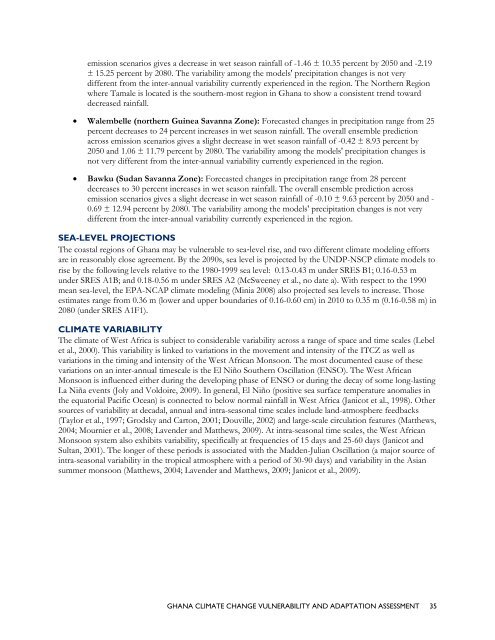ghana climate change vulnerability and adaptation assessment
ghana climate change vulnerability and adaptation assessment
ghana climate change vulnerability and adaptation assessment
- No tags were found...
Create successful ePaper yourself
Turn your PDF publications into a flip-book with our unique Google optimized e-Paper software.
emission scenarios gives a decrease in wet season rainfall of -1.46 ± 10.35 percent by 2050 <strong>and</strong> -2.19± 15.25 percent by 2080. The variability among the models' precipitation <strong>change</strong>s is not verydifferent from the inter-annual variability currently experienced in the region. The Northern Regionwhere Tamale is located is the southern-most region in Ghana to show a consistent trend towarddecreased rainfall. Walembelle (northern Guinea Savanna Zone): Forecasted <strong>change</strong>s in precipitation range from 25percent decreases to 24 percent increases in wet season rainfall. The overall ensemble predictionacross emission scenarios gives a slight decrease in wet season rainfall of -0.42 ± 8.93 percent by2050 <strong>and</strong> 1.06 ± 11.79 percent by 2080. The variability among the models' precipitation <strong>change</strong>s isnot very different from the inter-annual variability currently experienced in the region.Bawku (Sudan Savanna Zone): Forecasted <strong>change</strong>s in precipitation range from 28 percentdecreases to 30 percent increases in wet season rainfall. The overall ensemble prediction acrossemission scenarios gives a slight decrease in wet season rainfall of -0.10 ± 9.63 percent by 2050 <strong>and</strong> -0.69 ± 12.94 percent by 2080. The variability among the models' precipitation <strong>change</strong>s is not verydifferent from the inter-annual variability currently experienced in the region.SEA-LEVEL PROJECTIONSThe coastal regions of Ghana may be vulnerable to sea‐level rise, <strong>and</strong> two different <strong>climate</strong> modeling effortsare in reasonably close agreement. By the 2090s, sea level is projected by the UNDP-NSCP <strong>climate</strong> models torise by the following levels relative to the 1980‐1999 sea level: 0.13-0.43 m under SRES B1; 0.16-0.53 munder SRES A1B; <strong>and</strong> 0.18-0.56 m under SRES A2 (McSweeney et al., no date a). With respect to the 1990mean sea-level, the EPA-NCAP <strong>climate</strong> modeling (Minia 2008) also projected sea levels to increase. Thoseestimates range from 0.36 m (lower <strong>and</strong> upper boundaries of 0.16-0.60 cm) in 2010 to 0.35 m (0.16-0.58 m) in2080 (under SRES A1F1).CLIMATE VARIABILITYThe <strong>climate</strong> of West Africa is subject to considerable variability across a range of space <strong>and</strong> time scales (Lebelet al., 2000). This variability is linked to variations in the movement <strong>and</strong> intensity of the ITCZ as well asvariations in the timing <strong>and</strong> intensity of the West African Monsoon. The most documented cause of thesevariations on an inter-annual timescale is the El Niño Southern Oscillation (ENSO). The West AfricanMonsoon is influenced either during the developing phase of ENSO or during the decay of some long-lastingLa Niña events (Joly <strong>and</strong> Voldoire, 2009). In general, El Niño (positive sea surface temperature anomalies inthe equatorial Pacific Ocean) is connected to below normal rainfall in West Africa (Janicot et al., 1998). Othersources of variability at decadal, annual <strong>and</strong> intra-seasonal time scales include l<strong>and</strong>-atmosphere feedbacks(Taylor et al., 1997; Grodsky <strong>and</strong> Carton, 2001; Douville, 2002) <strong>and</strong> large-scale circulation features (Matthews,2004; Mournier et al., 2008; Lavender <strong>and</strong> Matthews, 2009). At intra-seasonal time scales, the West AfricanMonsoon system also exhibits variability, specifically at frequencies of 15 days <strong>and</strong> 25-60 days (Janicot <strong>and</strong>Sultan, 2001). The longer of these periods is associated with the Madden-Julian Oscillation (a major source ofintra-seasonal variability in the tropical atmosphere with a period of 30-90 days) <strong>and</strong> variability in the Asiansummer monsoon (Matthews, 2004; Lavender <strong>and</strong> Matthews, 2009; Janicot et al., 2009).GHANA CLIMATE CHANGE VULNERABILITY AND ADAPTATION ASSESSMENT 35
















